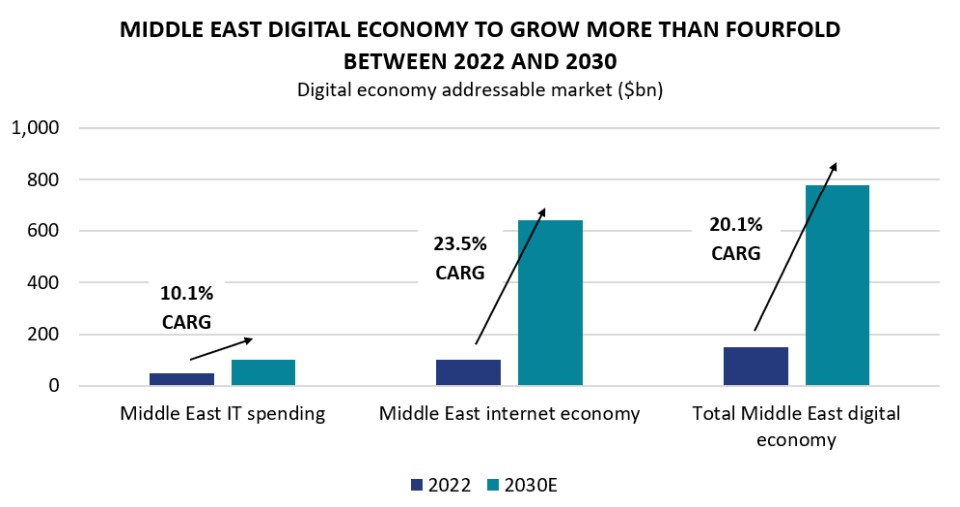Industry Thought Leadership
World’s Digital Horizon: Charting the Future of Technology, Policy, and Business
May, 2024As we enter the digital era, the global landscape of technology and telecommunications is undergoing a seismic shift. Driven by relentless innovation and a thirst for progress, this sector is revolutionizing how we live, work, and connect. For instance, Middle East's digital economy is expected to hit $780bn by 2030 and outpace global growth.
This article explores how Smart countries are flourishing and strategically employ strong ecosystems for collaboration, becoming driving forces for digital transformation.
A commitment to fostering collaboration between the government, businesses, and residents lies at the heart of their success. This collaborative framework serves as the foundation for striving digital transformation, setting the stage for innovative solutions that benefit the entire society.

Source: The National News magazine, World Bank, Gartner, Bloomberg Intelligence and UBS

Source: Swiss Bank UBS
Acknowledging the crucial role of telecommunications infrastructure, Smart countries position themselves as strategic enablers for digital transformation. With their resilient and reliable world-class connectivity infrastructure, these countries are at the forefront of digital technologies. By investing in advanced connectivity infrastructure, security, and sustainability, Smart countries will provide its population and businesses with the tools and capabilities necessary to compete.
Their commitment to innovation sustains the growth of innovative industries, such as e-commerce, e-health, e-education, and other high-impact sectors. By digitalizing the existing economic base and building or attracting new digital and technology players, these countries will create an innovative and borderless digital economy which will result in significant benefits.
Digital connectivity and emerging technologies are pivotal for future-ready ICT ecosystems. Such environments are driven by digitally skilled talents, progressive regulation, and early adoption of the latest and future technologies, including Artificial Intelligence (AI), Blockchain, and Quantum Computing.
To efficiently steer, monitor, and track the overall execution of the strategic aspirations and targets for the connectivity infrastructure, Smart countries will set clear governance guidelines and policies. This ensures that this vision is not only ambitious but also effectively executed to bringing tangible benefits to the population and businesses.
Strategic plans and regulatory framework
Smart countries are set to take on a leading role in the growth of the national digital ecosystem, bolstering attractiveness for international investments, providing the ecosystem for social development, and fostering innovation. The aim of such an ambitious vision is to integrate the advancement of the telecommunications and digital ecosystem, propelling it toward greater growth and prosperity.
The transformation into a gigabit society will offer high-capacity and quality services that will be accessible to the population and businesses independent on their conditions. The establishment of a dedicated Cloud Hub will facilitate independent international connectivity and a collaborative digital economy expansion.
These countries should have a plan that emphasizes progressive network resource management, the development of a thriving 5G ecosystem and innovation testbed, and the adoption of robust cybersecurity measures for international data exchange. In addition, theirs plans should include the implementation of a national Artificial Intelligence (AI) policy, a commitment to sustainability with new green data centers, and strategic investments in future technologies like 6G, open data models, and quantum computing to ensure readiness for the evolving ICT landscape.
To support such ambition, Smart countries are putting an effort in developing an optimal regulatory framework that will focus on 5 dimensions:
- A robust domestic and international connectivity should be established to function as the fundamental cornerstone of the nation’s rapidly expanding ICT ecosystem, ensuring long-term sustainable growth. These countries acknowledge the importance of sustained investments in its telecommunications infrastructure as seen in Hawaiki Nui network extension project, New Zealand.
- The convergence of the physical and software layers, fostering digital transformation. Leveraging the widespread 5G network infrastructure for IoT solutions, harnessing the capabilities of cloud computing, and integrating advanced technologies like AI are crucial elements for driving growth and development across industries. This will help in becoming leading players in ICT application development such as Singapore’s National AI Program.
- Attraction of international telecommunications and technology players into the countries similarly to Singapore’s integration of international collaborations in technology research.
- The development of a critical national infrastructure (CNI) sectors based on a secure digital environment, comprising a strong cybersecurity, data protection, and cross-border data flow posture to protect their intellectual property and sensitive data, giving a competitive edge in the global market as seen in Hong Kong as part of its investments in infrastructure for the “Smart Living” national project.
- The investment in attaining net-zero carbon emissions bolstering a green infrastructure which emphasizes the promotion of sustainable practices within the telecommunications sector, specifically targeting the development and adoption of environmentally-friendly hardware, software, and energy solutions such as Estonia’s largest carbon-free data centre in the Baltics.

